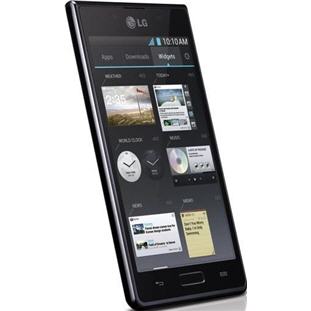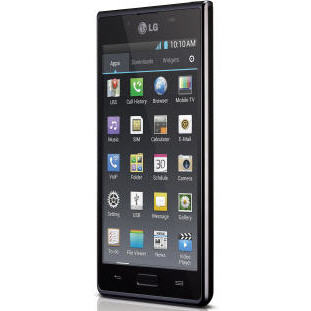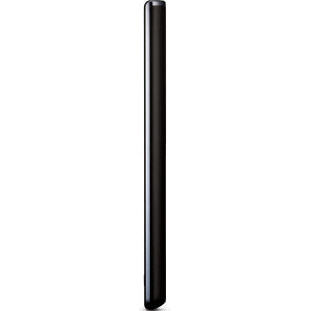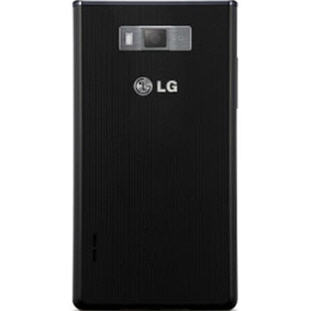Scope of supply:
Phone
Battery
Charger
USB-cable
Instruction
Entry
In LG's recently had to put it mildly,with smartphones in the middle price range. It must be confessed - from budget models, too, is not all right, but of expensive - only the Prada by LG, and even he has at the moment relatively modest performance for its flagship mobile phone.
Phone
Battery
Charger
USB-cable
Instruction
Entry
In LG's recently had to put it mildly,with smartphones in the middle price range. It must be confessed - from budget models, too, is not all right, but of expensive - only the Prada by LG, and even he has at the moment relatively modest performance for its flagship mobile phone.

It seems to me, partly to remedy this situation should be a new line of "smart phones» L-Style, introduced in early 2012 at the exhibition MWC (Mobile World Congress): Optimus L3, L5 and L7. In addition, in the near future will be the heavy artillery - Optimus Vu, 4X and 3D Max.


The design, size, controlsThe appearance of a smartphone is rectangular shape, where the lower and lateral faces slightly rounded over the top. Phone is almost completely copies the design of «Prada by LG 3.0» with some caveats: the L7 has a mechanical button "Home", while the LG 3.0 it is not, in the present apparatus Prada separate button to activate the front camera, and the P705 is not present, in a trendy gadget back side is made of a firm texture of plastic called «Prada Saffiano», in the ordinary LG Optimus longitudinal strips in the form of small braids.




Only when playing a video (maximum brightness, the maximum volume in the headphones) - slightly more than four hours.Only the game (for example, «Running Fred») - a little over four hours.Just surfing the web (for Wi-Fi, brightness 40%) - up to 10 hours.Just surfing the web (3G, brightness ranged from 40 to 100%) - 7 - 8 hoursIf you use the phone for about 12 - 13 hours, the battery is fully discharged if: 15-25 minutes a day, three hours of Wi-Fi-Internet (Twitter, email, downloading applications and installing them), about five hours with the mobile Internet while listening to music (a couple of hours).The USB charging for 3.5 hours, the charger for an hour less. By the way, the phone "feels" when connected to it powered by USB, and when the AC adapter: on-screen appears, stating that the device will charge slowly because of low current.In the "Energy" has the following items:
Auto-sync (on or off).
Wi-Fi (disable if not connected)
Bluetooth
Brightness (10 - 50%)
Time to turn off the screen (15 or 30 seconds, 1 minute)
Highlighting the front buttons (1.5 seconds on or off)
Enable or disable the display of the charge as a percentage
Flow Battery
Tips for each itemAntutu Tester
Communications capabilitiesThe smartphone works in networks GSM 850/900/1800/1900, HSDPA 900/1900/2100. The speed HSDPA - 21 Mbit / s, HSUPA - 5.76 Mb / s, EDGE - 236 Kbit / s, GPRS 32-48 Kbps / sec.There is a Bluetooth version 3.0 with A2DP. The module Wi-Fi (802.11 a / b / g / n) supports DLNA (Digital Living Network Alliance) - a standard that allows compatible devices to transmit and receive on your home network, different media content (images, music, videos) and display it in real time.The phone can be used as an access point (Wi-Fi hotspot). For data transfer and synchronization of USB 2.0 is present. Also, for "transportation" files used by Wi-Fi Direct. Sensitivity Wi-Fi did not cause any complaints that even in difficult conditions 1.2 shows the division.
Memory and Memory CardIn the LG P705 installed 512 MB of RAM, of which an average of no more than 110 free MB. Frankly, "will be enough", and it seems that memory is really not enough: when switching from one application to another machine can think as much as 2-3 seconds. It happens infrequently, but Skype is running this way. In this case, a council - more often unload the application from the "RAM".The installation of applications allocated about 4 GB Flash-memory, but is free only about 2.5 GB. So, the memory card (maximum volume - up to 32 GB) you need to buy. For example, Fly Turbo 8 GB and 5 GB free, although there is also the RAM to 1 GB.
CameraThis set of 5-megapiselny camera module with autofocus. There is a one-section LED flash and a front VGA-camera. The maximum size of photos - 2560x1920 pixels. A resolution of the video was surprised - 640x480 pixels (30 fps / channel with autofocus), despite the fact that almost all smart phones more expensive 10,000 rubles recorded in at least 720p. But the camera is to be commended: fast and accurate focus, the minimum distance to the object about 2-3 cm and good detail.Front camera can be used in Skype, but the other person sees you in green. A common problem is the application. We'll have to look for either a special assembly, or use other programs for video calling.A separate button to activate the camera there, so it runs through a shortcut in the menu or the "Screen Lock".Interface photo mode: Left - Activate the gate, switching between photo and video, the transition to the gallery, on the left - to switch on the front and back camera, zoom, brightness, modes and settings, from the top - the resolution, the shooting mode, memory, battery, and the number of remaining frames.For guidance on the sharpness of the need to touch the screen ("tachfokus") or just press the touch shutter button - it will auto focus.Options:
Flash (turn off, turn on, auto)
Focus (auto, face tracking)
Image size (5 MP, 3 MP, W3M, an MP and W1M)
Scene modes (Normal, Portrait, Landscape, Sports, Sunset and Night)
ISO (100, 200, 400, and auto)
White Balance
Color effects
Timer
Geo-
Shutter Sound
Auto @ MAIL_RU Auto (turn, turn, 2 or 5 seconds)
Memory (microSD card or internal memory)Interface photo mode: Left - Activate the gate, switching between photo and video, the transition to the gallery, on the left - to switch on the front and back camera, zoom, brightness, flash and configuration from above - the resolution, sound and battery life.Options:
The size of the video (VGA, MMS)
White Balance
Color effects
Geo-
Sound (recorded or not)
Auto @ MAIL_RU Auto (turn, turn, 2 or 5 seconds)
Memory (microSD card or internal memory)"Gallery" shows a slightly modified album Android 4.0.EXIF-information from a photo file:Characteristics of the video recorded on the main camera:
Format: MP4
Video: AVC, 2000 Mbit / sec
Resolution: 640x480, 30 fps /
Audio: AAC, 156 kbit / s
Channels: 1 channel, 48 kHzCharacteristics of the video recorded on the front camera:
Format: MP4
Video: AVC, 1600 Mbit / sec
Resolution: 640x480, 30 fps /
Audio: AAC, 156 kbit / s
Channels: 1 channel, 48 kHzExamples of photos:Sample video (MP4, 17 MB)
PerformanceThe device is equipped with LG Optimus L7 chipset Qualcomm MSM7227a. This chip is used in Samsung Galaxy Ace Plus, Galaxy Mini 2 and other smartphones. Oddly enough, but LG Optimus L3 is the same chip, just not functioning at 1 GHz and 800 MHz.Brief specification MSM7227a:
ARM Cortex-A5
DSP Hexagon QDSP5 350 MHz
Adreno 200 graphics accelerator
ARMv7 Architecture
Process technology - 45 nm.Unpretentious toys on it go without any problems. For example, the popular «Angry Birds Seasons» runs fast, the gameplay is not.«Samurai vs Zombies» or «Running Fred» go to the minor slowdown in the scenes with many objects.Even despite the fact that the whole interface works smoothly, in general, can not say that L7 operates smartly with applications. I noticed it after a third-party software installed. As I said above, it seems that the smartphone does not have enough RAM, not much processing power. Most likely to be released firmware that optimizes the operating system and hardware.Short facts:Benchmarks:Quadrant StandartAntutu BenchmarkNenamark 2KFS BenchmarkRL BenchmarkRD 3D BenchmarkCF Benchmark
NavigationThe smartphone is installed GPS-navigator. To test, I used the application "Navitel". Describe the installation program will not, just briefly mention that installing "Navitel" you need two files: APK (you can "take" even from Google Play) and map (or here).After starting the application agree with all the requests that will offer navigation. "Cold" start positioning LG P705 - about 7-8 minutes, the "hot" - about 15 seconds. Unfortunately, the satellites are determined by the room reluctantly, therefore, found the navigation difficult, only two or three. However, in an open space in good weather L7 has identified more than 8 satellites.During route guidance, you can see in the form of a flat or 3D, the top or the rotation. Available night mode or the standard map - day.To search for a destination, select one of the options, such as the address. Enter the city, street and house. Construction of the route in less than a second, the same amount of time required for the restructuring of the route in case of congestion or other unpleasant situations.Throughout the trip is voice support of various events: rotation, satellite reception conditions, etc.Smartphone Optimus L7 was an excellent assistant: with high-contrast screen and easily legible on the map "Navitel" to navigate a pleasure. A small "but": the search for satellites is slightly longer than most competitive models.
The software platformThe test sample runs on the operating system Google Android 4.0.3, and this is a significant plus, because so far most of the vehicles did not receive ICS. Build number - IML74K, version of the communication module - V10b-May-08-2012.
The shell and menuAs the design stands firm shell Optimus UI version 3.0. It has undergone many changes, and they all seemed to me interesting.To activate the backlight, press the power key or the "Home". On the "lock screen" provides information about the time, date, and the network. They are branded widgets. To configure them should go to "Lock Screen". It contains:
The choice of locking the screen (hold your finger, graphic key, PIN or password)
Wallpaper
Widgets and labels (labels are assigned to four, the widget is available 3 hours).To unlock, you need to run your finger across the screen. This function is very original: while moving your finger in a circle appears smooth "main desktop" (by analogy with the portal gun in the game «Portal»)."The main desktop" presented widgets and shortcuts. To configure it, you must click on the "Menu" and select the appropriate item, comprising: Animation (the animation to show or not);Effects on the screen(the main, the breeze, accordion, pan, carousel, Jeng, dominoes);Free;Browse wallpapers (whether or not scroll when scrolling desktop wallpaper);Rotating the screen (showing the first working table after the last one).Falling outside the upper pane contains shortcuts to quickly launch Wi-Fi, Bluetooth, GPS, or those that you set by pressing the button "Edit". On the same panel are the start button settings, and various notices. They can be removed by holding a finger on them or by clicking the cross at the top right."Four" labels can be replaced by other elements ("Menu" can not be removed). To view all desktops (there are 5), you pinch your fingers to move the center of the screen.Menu. At the top are tabs "Applications", "Loaded" and "Widgets", next - the button with the settings shortcuts. I liked the "More icons." If you activate it appears on the screen grid is 4x5, and 5x6. For some it will be a welcome addition.
Messages
Applications
Web Browser
MultimediaMusic PlayerFM-radioVideo player
Conclusion
Specifications:
Class: smartphone
Form Factor: candy bar
Connectivity: Wi-Fi (b / g / n /), Bluetooth 3.0 (A2DP), connector microUSB (USB 2.0) for charging / sync, 3.5mm headset jack
No comments:
Post a Comment